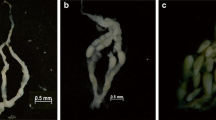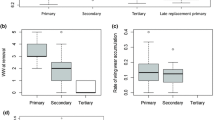Summary
An individual's rank in a dominance hierarchy is often based on size or weight, especially in insects. Foundresses of the social wasp, Polistes annularis, vary greatly in size as measured by wing length, dry weight, fat weight, and residue weight after fat has been extracted. Females that emerged from the same nest are much more similar in size to each other than they are to females that emerged from other nests. Within nests however queens are usually larger than their subordinates. Queens that emerged from one nest may be smaller than subordinates that emerged from another nest. We found no evidence of a group of females that are forced into being subordinates because of inadequate feeding as larvae. Females are also probably not attempting to begin new nests with females as different in size as possible from themselves since means and variances of winglength of females on new nests do not differ from those of all females emerging from that natal nest.
Similar content being viewed by others
References
Alexander RD (1961) Aggressiveness, territoriality and sexual behavior in field crickets (Orthoptera: Gryllidae). Behaviour 17:130–223
Alexander RD (1974) The evolution of social behavior. Annu Rev Ecol Syst 5:325–383
Batra SW (1966) The life cycle and social behavior of the primitively social bee, Lasioglossum zephyrum (Halictidae). Univ Kans Sci Bull 46:359–423
Bøvbjerg RV (1956) Some factors affecting aggressive behavior in crayfish. Physiol Zool 29:127–136
Breed MD (1976) The evolution of social behavior in primitively social bees: A multivariate analysis. Evolution 30:234–240
Brothers DJ, Michener CD (1974) Interactions in colonies of primitively social bees, III. Ethometry of division of labor in Lasioglossum zephyrum (Hymenoptera: Halictidae). J Comp Physiol 90:129–168
Brown JL (1970) Cooperative breeding and altruistic behavior in the Mexican jay, Alphelocoma ultramarina. Anim Behav 18:366–378
Craig R (1983) Subfertility and the evolution of eusociality by kin selection. J Theor Biol 100:379–397
Crook J, Gartlan JS (1966) Evolution of primate societies. Nature 210:1200–1203
Dropkin JA, Gamboa GJ (1981) Physical comparisons of foundresses of the paper wasp Polistes metricus (Hymenoptera: Vespidae). Can Entomol 113:457–461
Falconer DS (1960) Introduction to quantitative gentics. Ronald Press, New York, 365 p
Fisher RA (1932) Statistical methods for research workers. Oliver and Boyd, London
Folch J, Lees M, Sloane Stanley GH (1957) A simple method for the isolation and purification of total lipids from animal tissues. J Biol Chem 226:497–509
Gamboa GJ (1978) Intraspecific defense: advantage of social cooperation among paper wasp foundresses. Science 199:1463–1465
Gamboa GJ (1980) Comparative timing of brood development between multiple and single-foundress colonies of the paper wasp, Polistes metricus. Ecol Entomol 5:221–225
Gibo DL (1974) A laboratory study on the selective advantage of foundress associations in Polistes fuscatus. Can Entomol 106:101–106
Gibo DL (1978) The selective advantages of foundress associations in Polistes fuscatus (Hymenoptera: Vespidae): a field study of the effects of predation on productivity. Can Entomol 110:519–540
Ginsburg B, Allee WC (1942) Some effects of conditioning on social dominance and subordination in inbred strains of mice. Physiol Zool 15:485–506
Haggard CM, Gamboa GJ (1980) Seasonal variation in body size and reproductive condition of a paper wasp Polistes metricus (Hymenoptera: Vespidae). Can Entomol 112:239–248
Hall KRL, DeVore I (1965) Baboon social behavior. In: De Vore I (ed) Primate behavior. Holt, Rinehart, Winston, New York, pp 53–110
Hamilton WD (1964) The genetical theory of social behavior, I and II. J Theor Biol 7:1–52
Haubrich R (1961) Hierarchical behaviour in the South African clawed frog Xenopus laevis Daudin. Anim Behav 9:71–74
Hermann HR, Dirks TF (1975) Biology of Polistes annularis (Hymenoptera: Vespidae) I. Spring behavior. Psyche 82:97–108
Jarvis JUM (1981) Eusociality in a mammal: cooperative breeding in naked mole-rat colonies. Science 212:571–573
Klahn JE (1979) Philopatric and non philopatric foundress associations in the social wasp Polistes fuscatus. Behav Ecol Sociobiol 5:417–424
Lin N, Michener CD (1972) Evolution of sociality in insects. Q Rev Biol 47:131–159
Lowe ME (1956) Dominance-subordinance relationships in the crawfish Cambarellus shufeldii. Tulane Stud Zool Bot 4:139–170
McDonald AL, Heimstra NW, Damkot DK (1968) Social modification of agonistic behavior in fish. Anim Behav 16:437–441
Metcalf RA, Whitt GS (1977) Intranest relatedness in the social wasp Polistes metricus. Behav Ecol Sociobiol 2:339–351
Nie NH, Hull CH, Jenkins JG, Steinbrenner J, Bent DH (1975) Statistical package for the social sciences. McGraw-Hill, London New York, 675 p
Noonan KM (1981) Individual strategies of inclusive-fitness-maximizing in Polistes fuscatus foundresses. In: Alexander RD, Tinkle DW (eds) Natural selection and social behavior: recent research and new theory. Chiron Press, New York, pp 18–44
Pardi L (1948) Dominance order in Polistes wasps. Physiol Zool 21:1–13
Parker GA (1974) Assessment strategy and the evolution of fighting behavior. J Theor Biol 47:223–243
Pratte M (1979) Mobilité des fondatrices de Polistes gallicus. L. In: Cherix D (ed) Ecologie des Insectes Sociaux, pp 133–140
Pratte M (1982) Relations anterieures et association de fondation chez Polistes gallicus. L. Insectes Soc 29:352–357
Rabb GB, Woolpy JH, Ginsburg BE (1967) Social relationships in a group of captive wolves. Am Zool 7:305–311
Rau P (1930) Mortality of Polistes annularis wasps during hibernation. Can Entomol 62:81–83
Richards OW (1971) The biology of the social wasps (Hymenoptera: Vespidae). Biol Rev Cambridge Philos Soc 46:483–528
Richards SM (1974) The concept of dominance and methods of assessment. Anim Behav 22:914–930
Röseler PF, Röseler I, Strambi A (1980) The activity of the corpora allata in dominant and subordinated females of the wasp, Polistes gallicus. Insectes Soc 27:97–107
Rowell TE (1974) The concept of social dominance. Behav Biol 11:131–154
Scott JP, Fredericson E (1951) The causes of fighting in mice and rats. Physiol Zool 24:273–309
Siegel S (1956) Nonparametric statistics for the behavioral sciences. McGraw Hill, New York, 312 pp
Sigurjonsdottir H, Parker GA (1981) Dung fly struggles: evidence for assessment strategy. Behav Ecol Sociobiol 8:219–230
Sokal RR, Rohlf FJ (1969) Biometry. Freeman, San Francisco, 776 pp
Strassmann JE (1979) Honey caches help female paper wasps (Polistes annularis) survive Texas winters. Science 204:207–209
Strassmann JE (1981a) Wasp reproduction and kin selection: Reproductive competition and dominance hierarchies among Polistes annularis foundresses. Fla Entomol 64:74–88
Strassmann JE (1981b) Parasitoids, predators and group size in the paper wasp, Polistes exclamans. Ecology 62:1225–1233
Strassmann JE (1983) Nest fidelity and group size among foundresses of Polistes annularis (Hymenoptera: Vespidae). J Kans Entomol Soc 56:621–634
Strassmann JE, Orgren MCF (1983) Nest architecture and brood development time in the social wasp, Polistes exclamans (Hymenoptera: Vespidae). Psyche 90:237–248
Turillazzi S (1980) Seasonal variations in the size and anatomy of Polistes gallicus (L.) (Hymenoptera Vespidae). Monit Zool Ital (N.S.) 14:63–75
Turillazzi S, Pardi L (1977) Body size and hierarchy in polygynic nests of Polistes gallicus (L.) (Hymenoptera: Vespidae). Monit Zool Ital (N.S.) 11:101–112
Turillazzi S, Piccioli MTM, Hervatin L, Pardi L (1982) Reproductive capacity of single foundresses and associated foundress females of Polistes gallicus (Hymenoptera Vespidae). Monit Zool Ital (N.S.) 16:75–88
West MJ (1967) Foundress associations in polistine wasps: Dominance hierarchies and the evolution of social behavior. Science 157:1584–1585
West-Eberhard MJ (1969) The social biology of polistine wasps. Misc Publ Mus Zool Univ. Mich 140:1–101
West-Eberhard MJ (1975a) The evolution of social behavior by kin selection. Q Rev Biol 50:1–34
West-Eberhard MJ (1975b) Estudios de las avispas sociales (Hymenoptera: Vespidae), del Valle del Cauca. I. Objectivos, metodos, y notas para facilitar la identification de especies communes. Cespedesia 4:245–267
Wilson EO (1971) The insect societies. Belknap Press of Harvard Univ Press, Cambridge, Mass, 548 pp
Wilson EO (1975) Sociobiology. Belknap Press of Harvard Univ Press, Cambridge, Mass, 697 pp
Author information
Authors and Affiliations
Rights and permissions
About this article
Cite this article
Sullivan, J.D., Strassmann, J.E. Physical variability among nest foundresses in the polygynous social wasp, Polistes annularis . Behav Ecol Sociobiol 15, 249–256 (1984). https://doi.org/10.1007/BF00292986
Received:
Accepted:
Issue Date:
DOI: https://doi.org/10.1007/BF00292986




